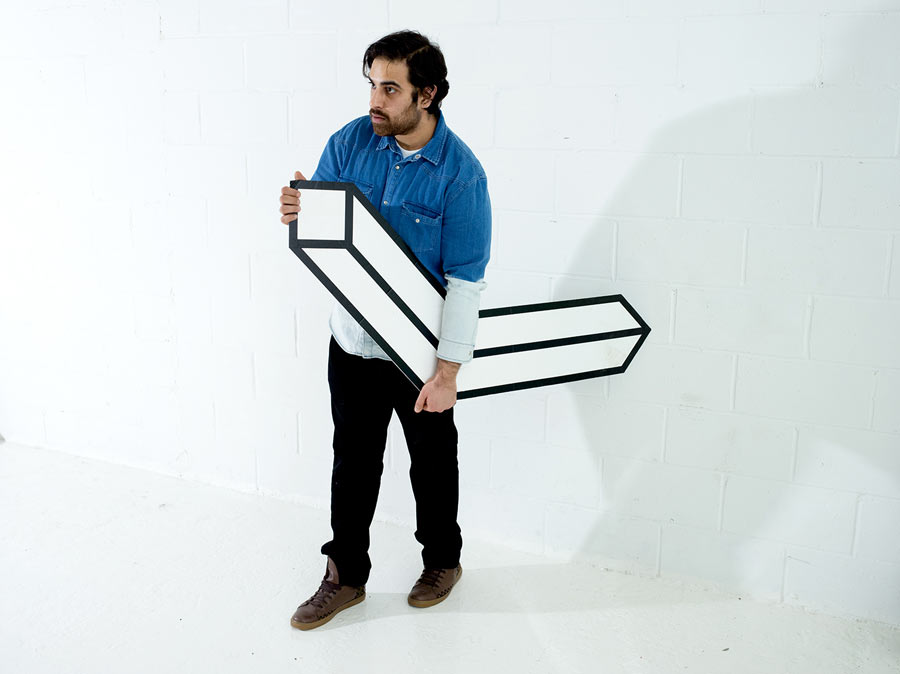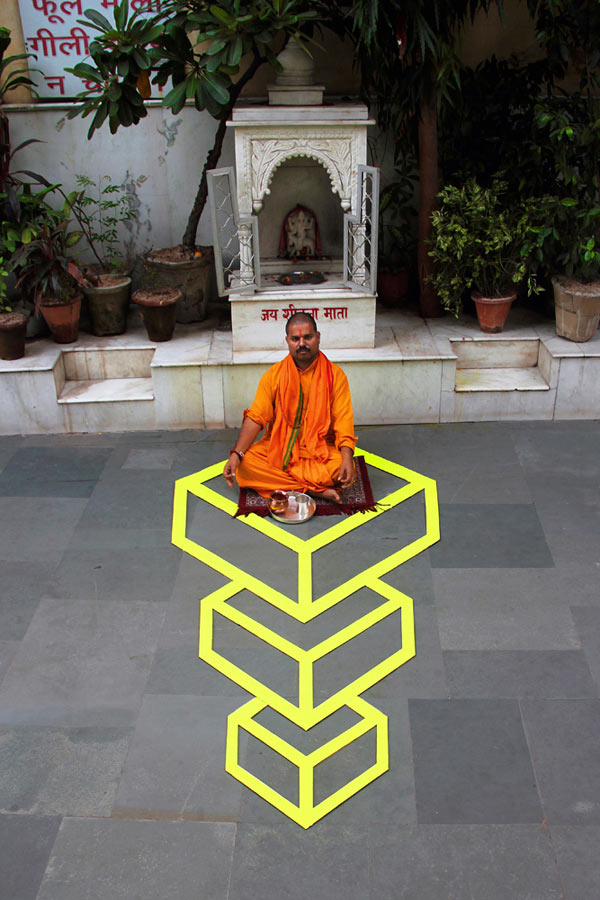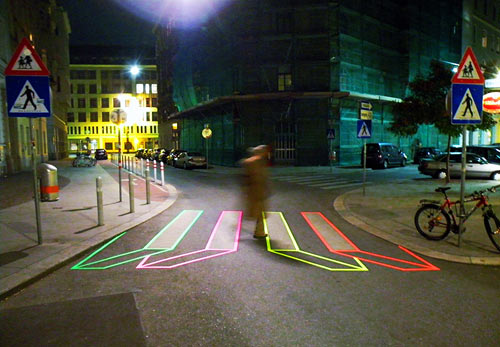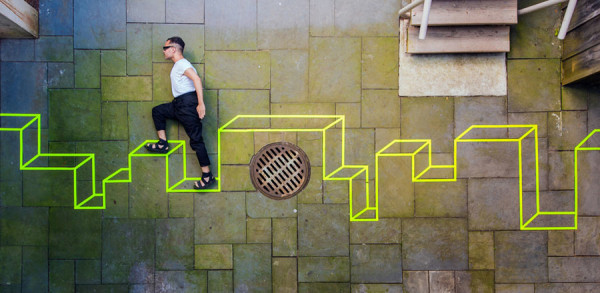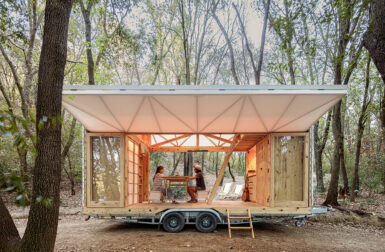The art of Aakash Nihalani was brought to my attention earlier this year and I’ve been hooked on his work ever since. The New York-born, Jersey-raised, Brooklyn-based artist initially went to school for political science but ended up finding his calling early, finishing with a BFA. “I had creative inclinations as a kid but art as a career wasn’t an option the way I was brought up. Instead I was steered towards professions like law or medicine. When I did switch to art, I think being an outsider gave me a fresh perspective on what art was, or could be, which allowed me to experiment freely,” he explains. We’re so glad he pursued those early creative inclinations!
Building cubes, rectangles and other shapes out of mostly tape, the very nature of his work seems simple at first, but he builds complexity through perspective and dimension, a trait of his work that I think really embodies MSN’s design philosophy of fierce reductionism. He currently installs his mind-bending art all over New York City, as well as overseas in India, France and beyond, turning places like alleyways and parks into visual playgrounds. Like MSN, in much of his work, Nihalani creates projects that are “perfect for touch” and require human or object interaction, like Nature Walk or Sum Times. I often hope when I’m in NYC that I am lucky enough to stumble upon one of his installations.
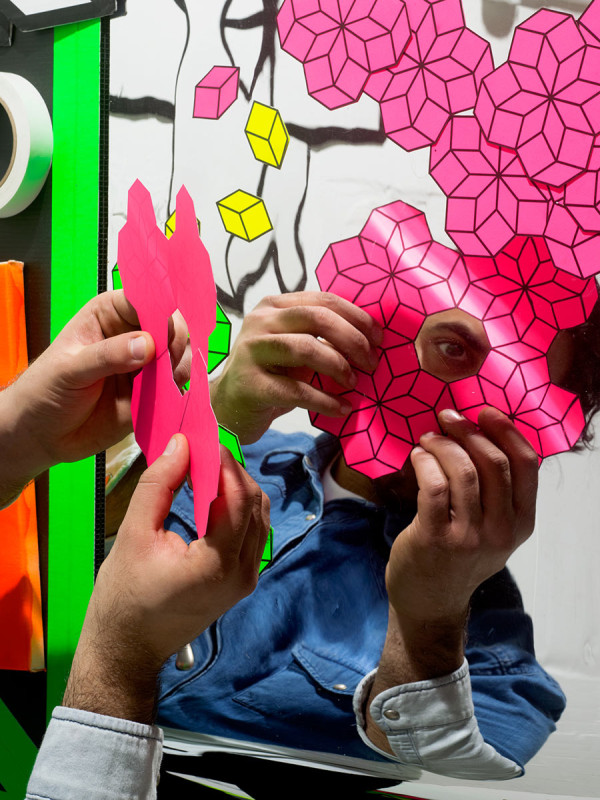
Photo by Noah Kalina
The fact that some of his artwork is taken down within days–or even hours–of being installed, shows a real commitment to staying in the moment. He establishes more permanence with exhibitions as well as a pretty eye-explosive blog called Eye Scream Sunday. I got a chance to speak with him and see what he’s up to – read the interview below:
When did you start playing around with 3D shapes – did you start drawing them first? How did it all come about?
I took a bunch of printmaking classes when I first got into art school. I gravitated toward screen-printing, probably because it was less tedious than other printing methods like litho or etching, and I was able to print quickly.
Coming from a suburban neighborhood, I was struck by the urban architecture of the city: big boxes, filled with smaller boxes.
Early on I started exposing screens with graphics of cubes. I would print hundreds of them individually on different papers, cut them out, and then arrange them into different compositions. I obsessed over the shape, it always seemed like it deserved more time and exploration in the way it could repeat and interact with itself.
For your street installations, do you typically look for a space first or do you create the work first and then scout a location?
I walk until I find a space that catches my eye. If the space isn’t conducive to having tape directly on it, I’ll go back to the studio and make a freestanding version of the design by taping onto a corrugated board and then cutting it out. Problem solving a piece into a specific location becomes a fun challenge, and I find satisfaction in having a dialogue with the environment and people in it.
Your work is very simplistic and yet there are complex spatial and dimensional aspects to it. Would you consider yourself a minimalist or a maximalist?
Minimalist. I work towards using the least in order to achieve the most.

Photo by Noah Kalina
What made you decide to use tape as a medium? Do you have a favorite medium?
I came upon tape as a medium sort of by accident. I had a painter’s roll that I was using to stick some screen prints on wall for a student exhibition. There was a pedestal in the space that was casting a shadow on the floor that matched the shapes I was using in my prints, so I outlined the shadow with the tape. Clouds parted…
I was always really attracted to making work in public spaces and once I started using tape, I felt comfortable in working outdoors with it since it was such a non-threatening material. Also, tape by nature makes straight lines and because all my work is linear, I’m able to work with the medium instead of against it.
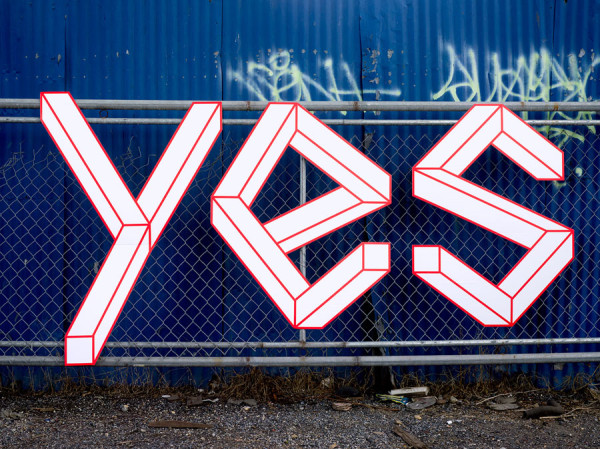
Photo by Noah Kalina

Photo by Noah Kalina
Does your art reflect your own personal style?
I have obsessive-compulsive tendencies so the aesthetic comes out as ordered and structural. I also think my sense of humor comes out in my work.
Where do you draw influence?
A series of window panes that make a math equation, a stop sign set against industrial Brooklyn architecture, a violinist playing on the subway platform, a patch of exposed brick on a concrete wall, a vine growing in the shape of a waterfall, pyramids of stacked fruit at the corner stand, discolored tiles on the train station down the block.

Photo by Noah Kalina

Photo by Noah Kalina
What is your process like?
I like moving back and forth between mediums to keep things interesting. I find that work I do in one medium, like animation, can inform or expand the things I can create or conceive of in another medium, like painting or sculpture. I’m always finding new ways to express an idea, so my process is still evolving.
Your work is interactive. Whether it’s moving (like an animated gif) or installed on the street, it beckons you to interact with it in some way. Is this magnetism and interaction part of the works as well?
Most of my work is only complete, or successful, when that interaction happens.
I became frustrated making work in studios, then packing it up and hiding it in storage until I could find a way to exhibit it. Working outdoors allows me to close the gap between creation and exhibition, which, for me, brings the process back to life.
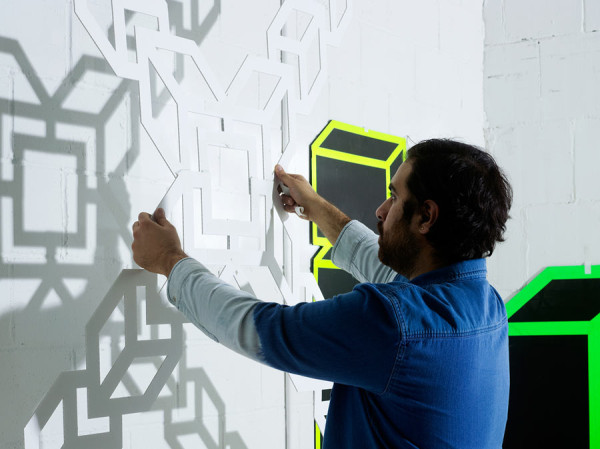
Photo by Noah Kalina
What are you currently working on?
I’m working with MTA Arts in Transit and Two Trees on a large installation at the York Street Station in Brooklyn. What’s next? Getting back in the studio to work on a solo show in Berlin later this year. Stay tuned!
What do you want to be best known for? How will you leave your mark?
My marks usually get torn down after a couple weeks.
![]() This post made possible by MSN. The new, faster MSN keeps you in the know.
This post made possible by MSN. The new, faster MSN keeps you in the know.


